Gujarat Tour Diary: Day 13 |Kutch Tourist Circuit
(If you have come to this page while searching for some travel related information of Gujarat, I suggest you start from Day 0 of this travelogue.)
I have not told you about Kutch so far. Here are the details from the internet:
Kutch
{Kutch, with an area of 45,652 km², is the largest district of India. The administrative headquarters is in Bhuj which is geographically in the center of district.
Kutch literally means something which intermittently becomes wet and dry; a large part of this district is known as Rann of Kutch which is shallow wetland which submerges in water during the rainy season and becomes dry during other seasons. The same word is also used in the languages of Sanskrit origin for a tortoise. The Rann is famous for its marshy salt flats which become snow white after the shallow water dries up each season before the monsoon rains.
Kutch is virtually an island, surrounded by the Arabian Sea in the west; the Gulf of Kutch in south and southeast and Rann of Kutch in north and northeast. The border with Pakistan lies along the northern edge of the Rann of Kutch, of the disputed Kori Creek.
Wildlife sanctuaries and reserves: From Bhuj city, various ecologically rich and wildlife conservation areas of the Kutch district can be visited such as Indian Wild Ass Sanctuary, Kutch Desert Wildlife Sanctuary, Narayan Sarovar Sanctuary, Kutch Bustard Sanctuary, Banni Grasslands Reserve and Chari-Dhand Wetland Conservation Reserve.
Buy: Kutch is famous for exquisite crafts like embroidery, applique work bed sheets etc. Bandhani (tie and die) fabrics, enameled silverware and other handicrafts are also found here. Around the Wild Ass Wildlife Sanctuary, you may shop for Patola Silk Sarees, Bandhanis, Ghagra-cholis and marriage costumes. You will also find interesting wall hangings, embroidered quilts, cradle clothes, cloth toys, embroidered footwear, lacquer furniture and curios. Kutch is very much spread over west-south of Rann & it is difficult to go without escorts.
Guide: Mr Machchar Dinesh is a very fine guide, 075671 35322, charging Rs 1200/day. He is available near BAPS SNM.
Stay: Close to the Aina Mahal/Prag Mahal area. That’s where most of the interesting places are.
There can be traffic jams on holidays and Sundays, for permits / temples / Kalo Dungar etc; source: Internet}.
That was from the internet. I have told you in the last post (Day 12) about the difficulties (with respect to time) in covering the Kutch circuit. Here is a map of the same with all the routes, so that you will understand the intricacies in a better way.
Major tourist destinations and connecting road networks in Kutch District. Only Bhuj has got better Lodging facilities.
Now let us not worry about the tourist circuits of Kutch. We have already finished Little Rann of Kutch. Now let us start covering one by one. And in the process let us see all the circuits. If there is any circuit that we can’t cover, then I will tell you about it at the end.
Our first hurdle was Little Rann of Kutch. And the second hurdle was getting the permit during office hours. Having completed both, we wanted to finish one circuit after the other as early as possible.
Our Indian Standard Time (IST) is based on the time at Mirzapur near Allahabad in UP. Which means, the sunrise time at Mirzapur is the actual sunrise time. You would have seen lot of people saying that the Sun rises very early in Arunachal Pradesh, and the Sun rises very late in Kutch.
Actually the Sun does not require any alarm to get early or late; but it is we, who do not know that our IST is based at Mirzapur. So, the day starts very late at Bhuj, and when the Sun rises, it will be 7.10 am or so at this place (during January month). If we have to start the Bhuj local sight seeing, then we will be wasting our time till around 10 am. So we decided to take up the Koteshwar Circuit in the early morning.
We got up quite early and left Bhuj at 5.50 am. ‘Thank you, Google Maps’ we would have said these words at least thousand times in our tour so far. Otherwise who is there to give the directions towards Koteshwar at this odd time. As Maps was giving the directions, we drove towards Koteshwar.
I have already told that I have seen more wildlife during my travel outside the safari route than during the safaris. It got repeated here also. As we were on the road early morning, we saw Neelgais, Fox, and Peacocks on our way. If I am correct, almost all uninhabited places of Kutch regions have wildlife. We must start early to see them.


In fact while driving in these Bhuj roads, some how I was feeling like I was in Leh. There were few similariteies between Leh & Bhuj. Both are barren lands, sparsely populated, arid climate, near to the border etc. And to me the topography of Bhuj was matching that of Leh, except the mighty Himalayan mountains. (Of course, you need not agree with me)
The first place on our itinerary was Mata no Madh.
Mata no Madh
{This place houses the famous Ashapura Mata temple, the head deity of Kutch and Kuldevi of Jadeja rulers. The Ashapura Mata Temple was built in the 14th century by two Karad Vanias, Ajo and Anagor. The earthquake in 1819 damaged the temple. Within 5 years Sundarji Shivji and Vallabhaji, two Brahmakshatriya persons repaired it. This ancient temple is now 58′ long, 32′ wide and 52′ tall. Once again the earthquake of 2001 shook it and its dome tumbled down. However, very soon it was repaired once again and now it stands with a new grandeur.
During Navaratri times, lakhs of devotees come to pay a visit to temple at Mata no Madh, walking on foot from various places in Gujarat, Rajasthan, Maharashtra, Andhra Pradesh and Karnataka States}
We reached MNM at 7.15 am. Even though we were the first to arrive by car, there was already a bus standing with some devotees. We didn’t know from where it had come.
Mata no Madh temple
The next place on our list was Guhar Moti.
Guhar Moti
{It is the western-most inhabited village in India. It is located near the disputed Sir Creek and the Koteshwar temple, at 23.713°N 68.032°E. The village comes under Narayan Sarovar panchayat}
Now you will ask me what is at Guhar Moti. Yes, there is nothing, absolutely nothing. Like wise, there is nothing at Kibithu (East), Siachen Base (North), and Indira Point (South). I have told you that for us, many times the journey itself is the destination. This Guhar Moti is the leftmost inhabited village of India. We just wanted to take our photographs there as a memory of going there.
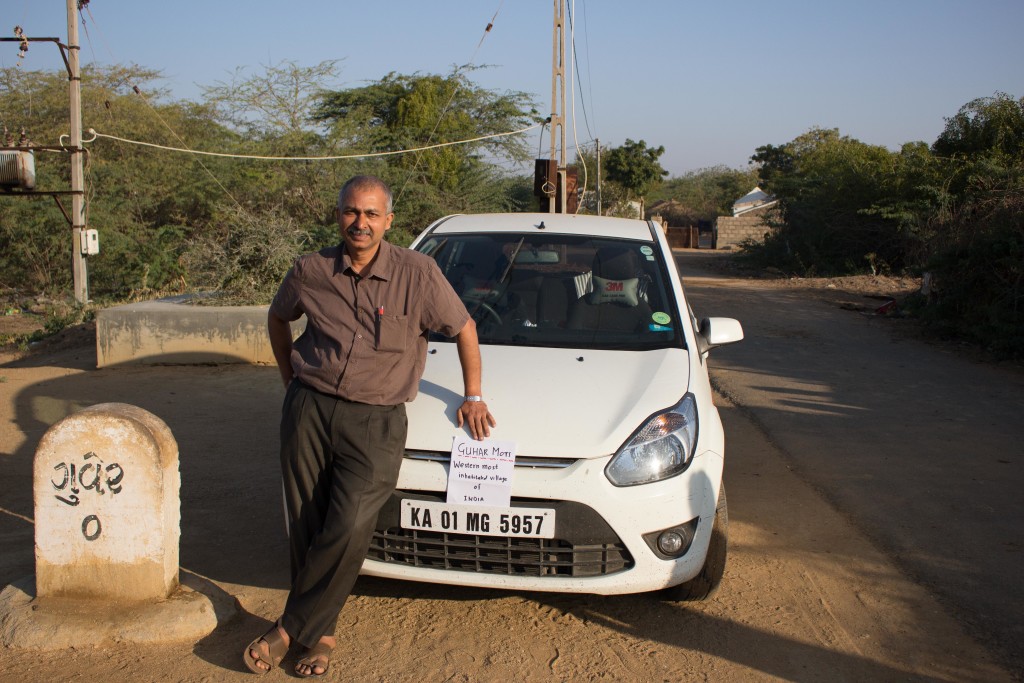
And this is the photo when I went to Kibithu, the eastern most point of India.
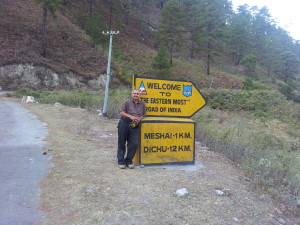
You may read about my visit to Kibithu here. And the road distance between Kibithu and Guhar Moti is 3737 kms (not aerial distance). That is the approximate width of India.
From Guhar Moti, we went to Koteshwar.
Koteshwar Temple
{You find the Koteshwar Temple, at a place where the immensity of dry land meets the vastness of the sea. The only point that breaks the skyline from the flat brown horizon to the east and the wide blue horizon to the west is the point of the Koteshwar Temple, the last outpost of human construction at the westernmost limit of India. Koteshwar is conducive to contemplating emptiness, pondering the place of humanity on earth}
This is one beautiful temple and place not to be missed in the Kutch circuit. The temple is simple yet beautiful. More than that, the whole location along with the Jetty makes it a place worth to visit.
In a way, this can be compared to the Kanyakumari Temple. While the Kanyakumari is in the southern tip of our mainland, the Koteshwar is in the western tip of our mainland. Whereas Kanyakumari is always crowded, Koteshwar is calm and quiet.
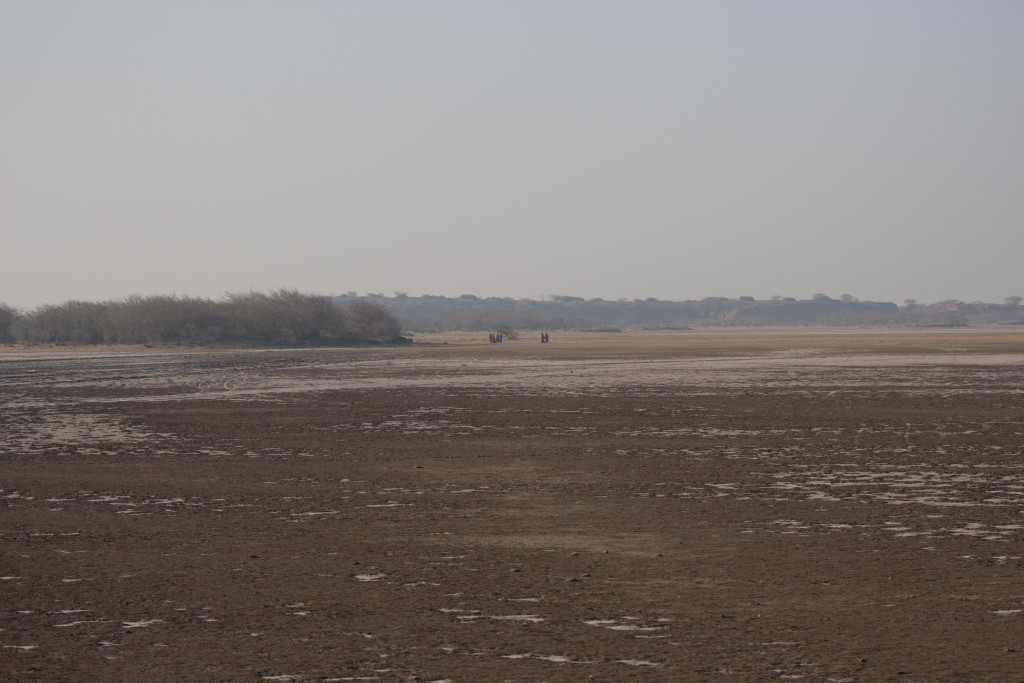
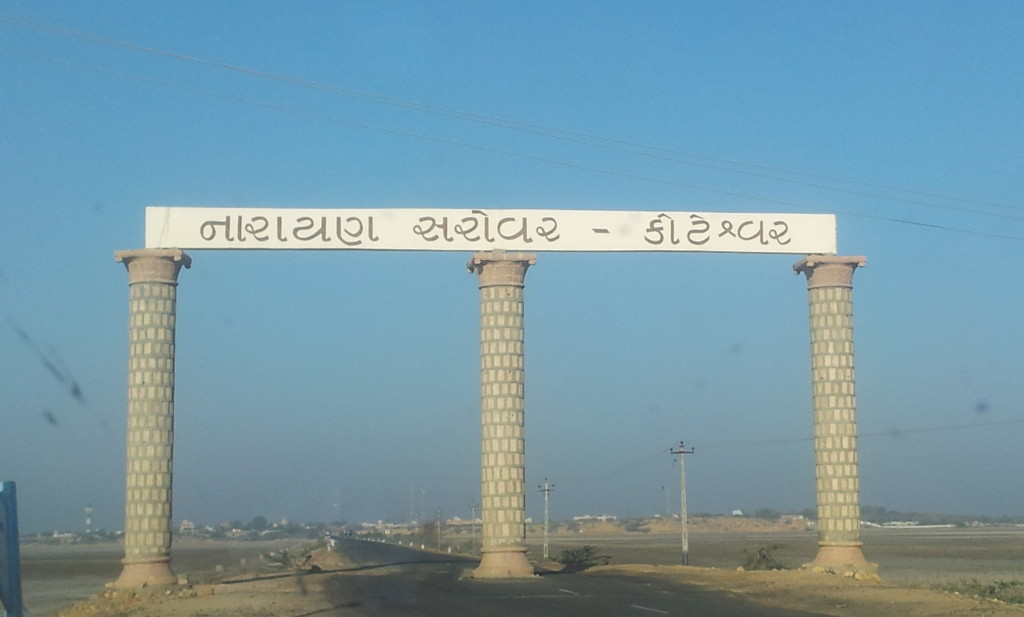
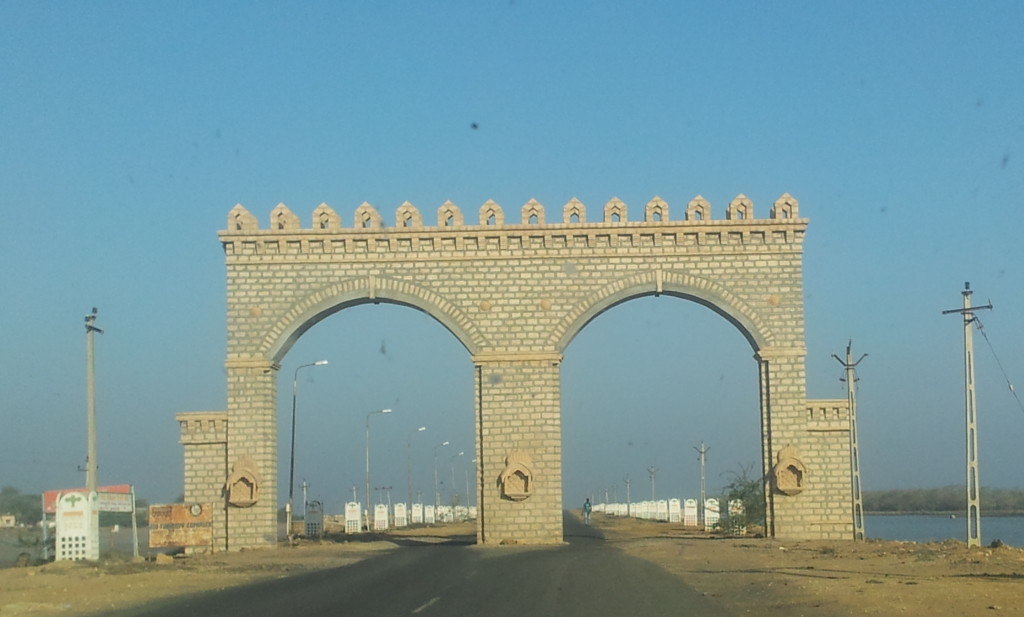

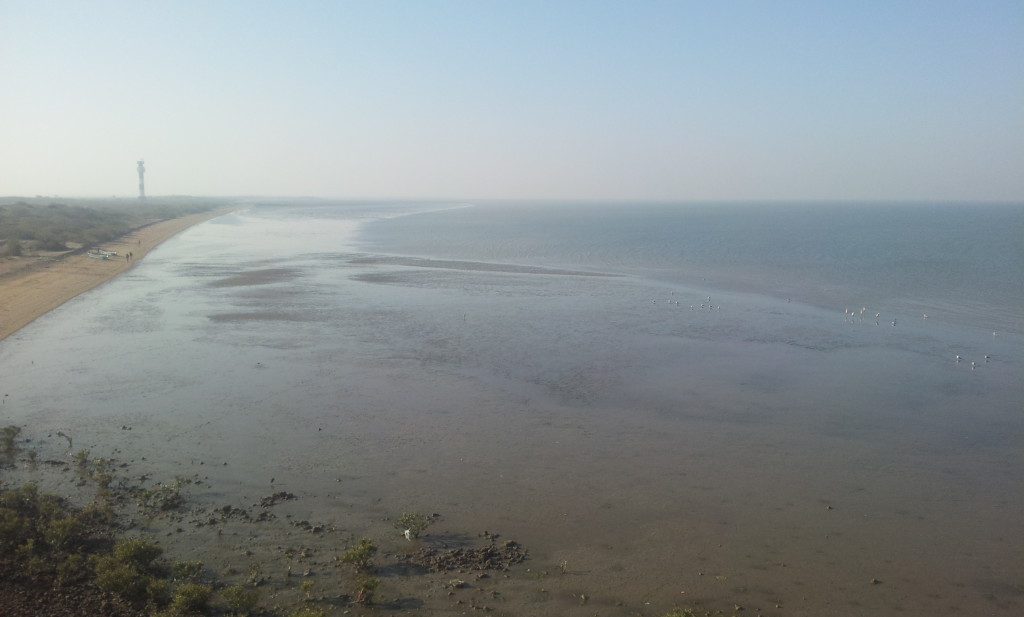
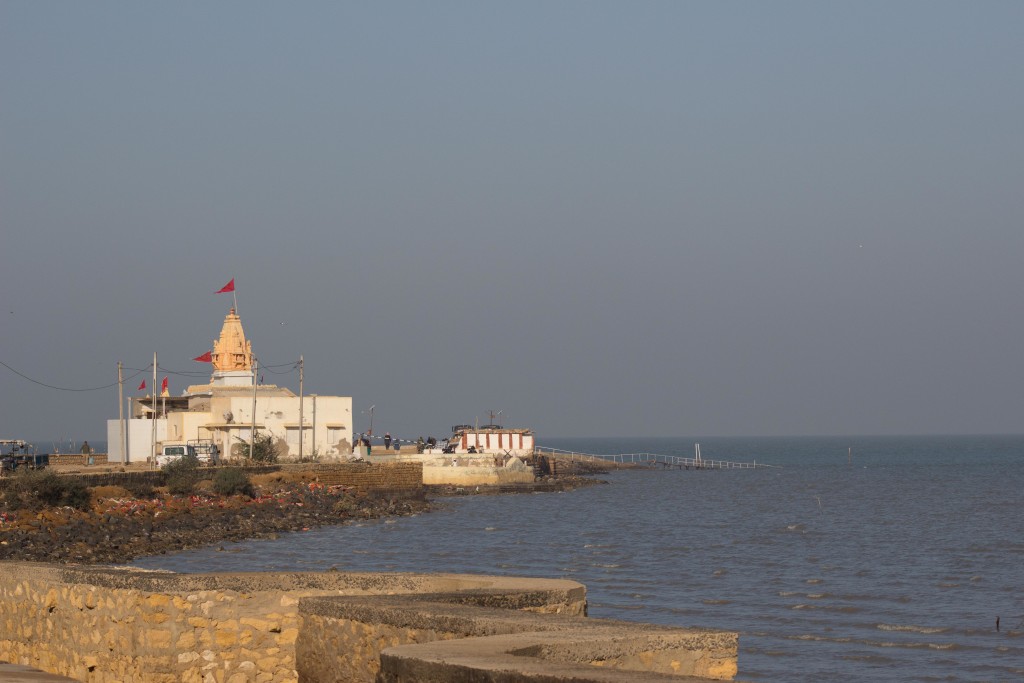

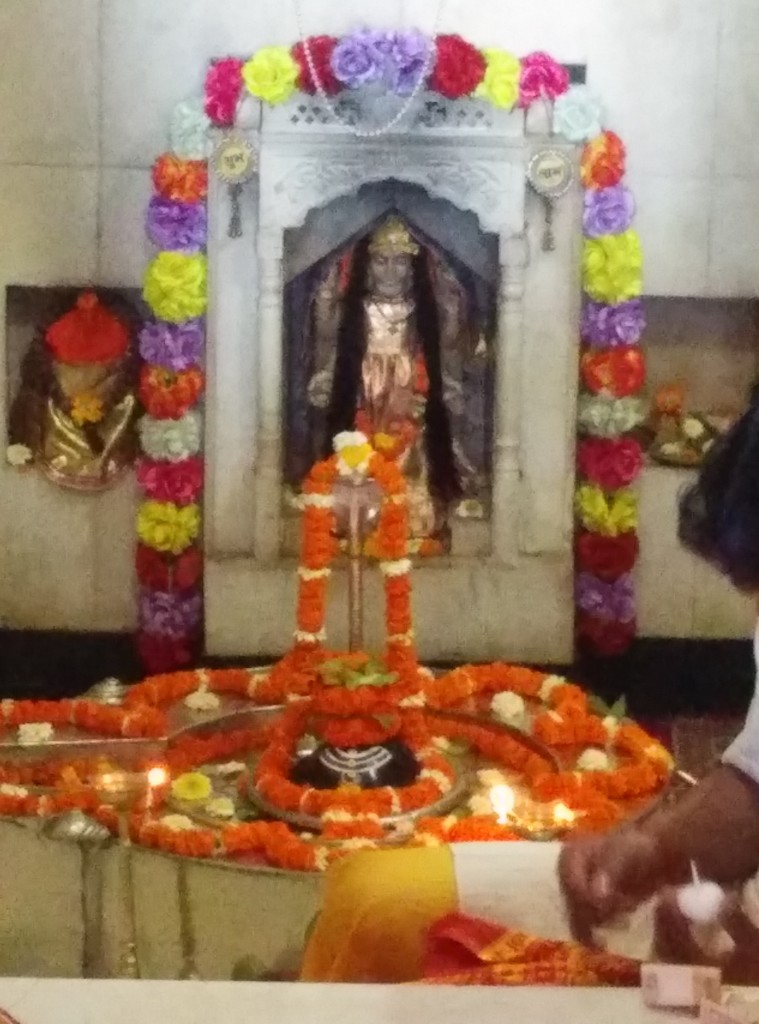


And unfortunately I don’t have a digital photo of Kanyakumari Temple and the Vivekananda Memorial in my album, to put it here.
Narayan Sarovar & Wildlife Sanctuary
{Narayan Sarovar Lake is one of the 5 holy lakes, along with Mansarovar-Tibet, Pampa-Karnataka, Bhuvaneshwar-Orissa and Pushkar-Rajasthan. The lake is associated with a time of drought in the Puranic area, when appeared in response to the fervent prayers of sages and touched the land with his toe, creating the lake, now revered as holy to bathe in. There are temples of Shri Trikamraiji, Laxminarayan, Govardhannathji, Dwarkanath, Adinarayan, Ranchodraiji and Laxmiji etc.
Narayan Sarovar is home to wildlife, including many species of mammals, reptiles, and birds. The principle species here is the chinkara, an Indian gazelle. In this harsh landscape, only animals well-adapted to the desert climate can thrive, with extreme heat, high winds etc. For this reason, many species can be seen here that are not easy to find elsewhere}
Of those 5 holy lakes, except the Bhuvaneshwar-Orissa, I have seen the other four lakes now. But what a sad story. Even though I have seen Narayan Sarovar, I can’t say that I have actually seen it, because there was no water in the lake. The lake had completely dried up. We visited the Lake and the temples on the shore of the lake.
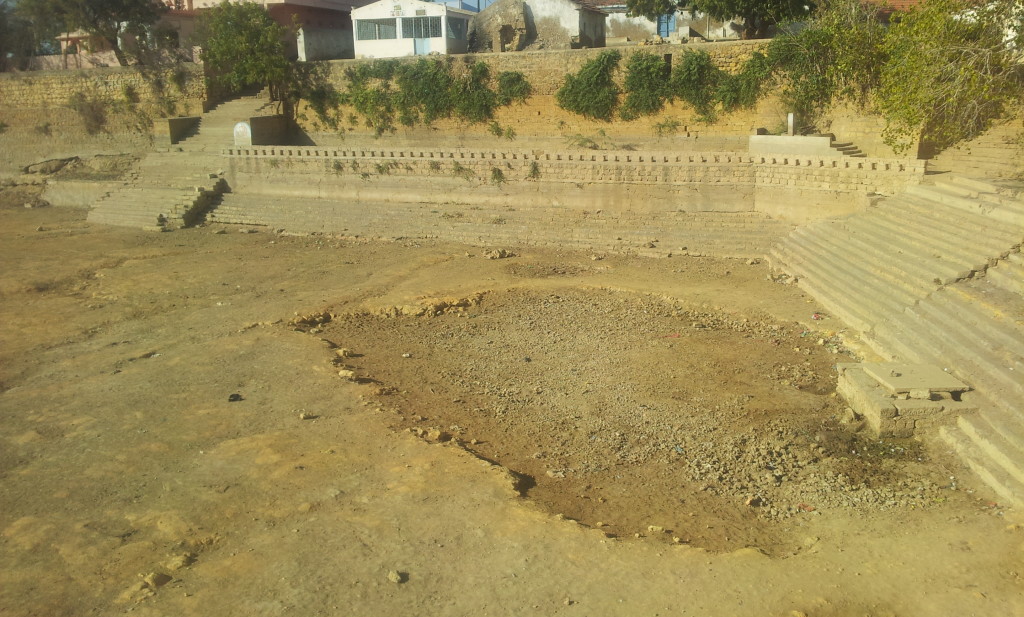
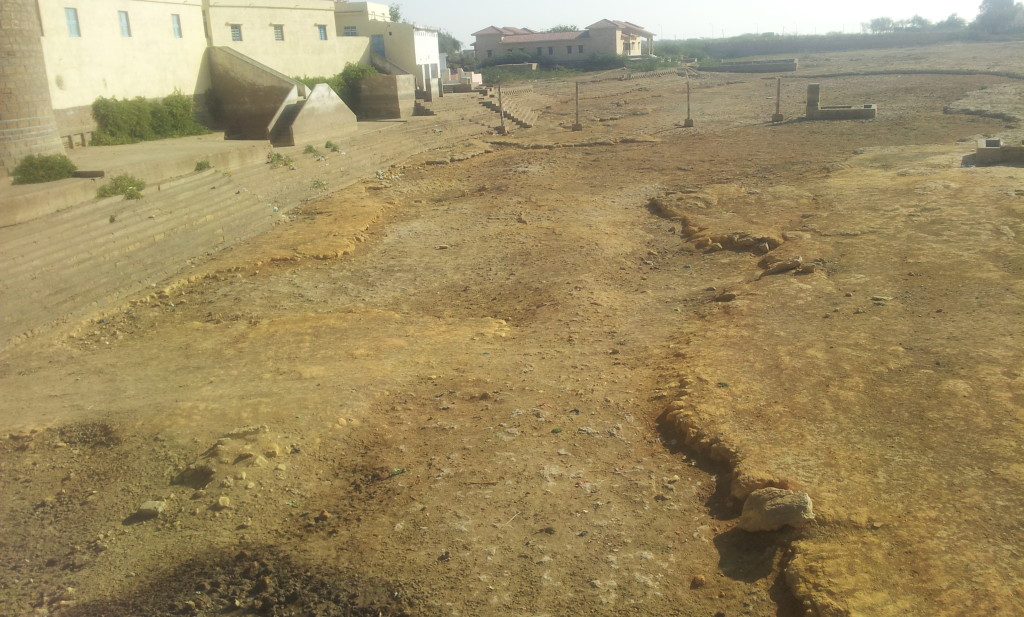

While we were coming out of the temple, we saw a paperwallah giving today’s newspapaer to these two beggars. It must be a daily affair, we thought. And these beggars started reading the newspaper. Oh, this is the miracle of Narayan. What else can I say? Most of our educated people don’t read newspapers, leave alone buying them. And at Narayan Sarovar even the beggars are reading it. That too in this remote corner of India !!
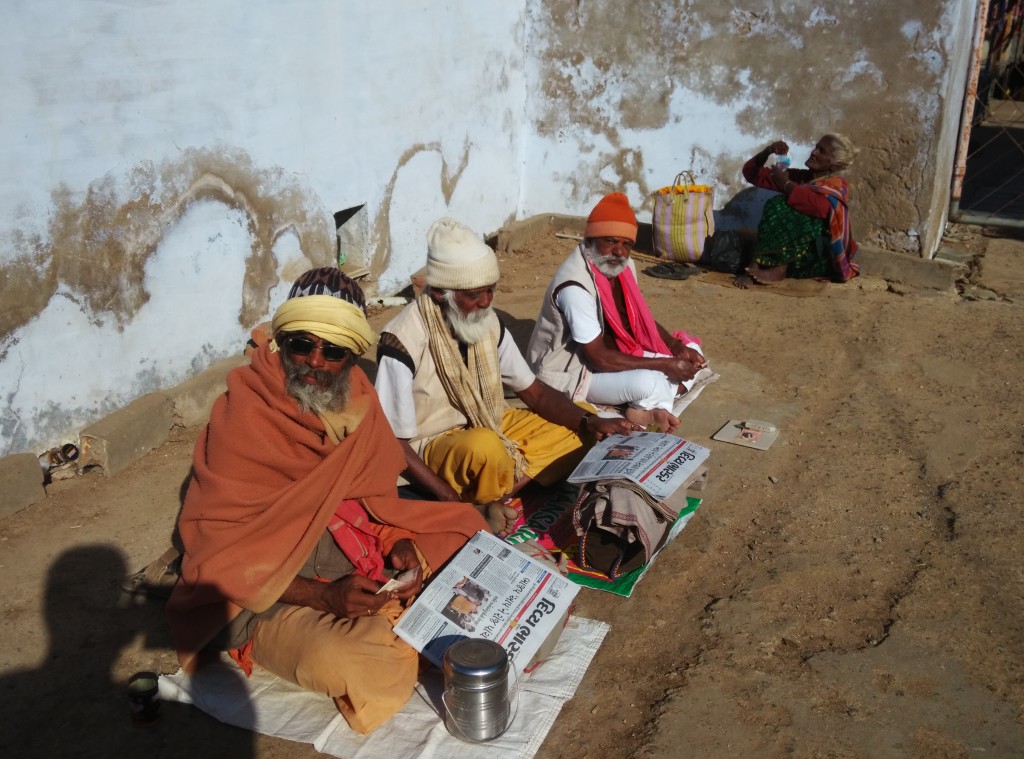
We came out and had our sumptuous Gujarati breakfast. Again, luckily we did not face any problem later.
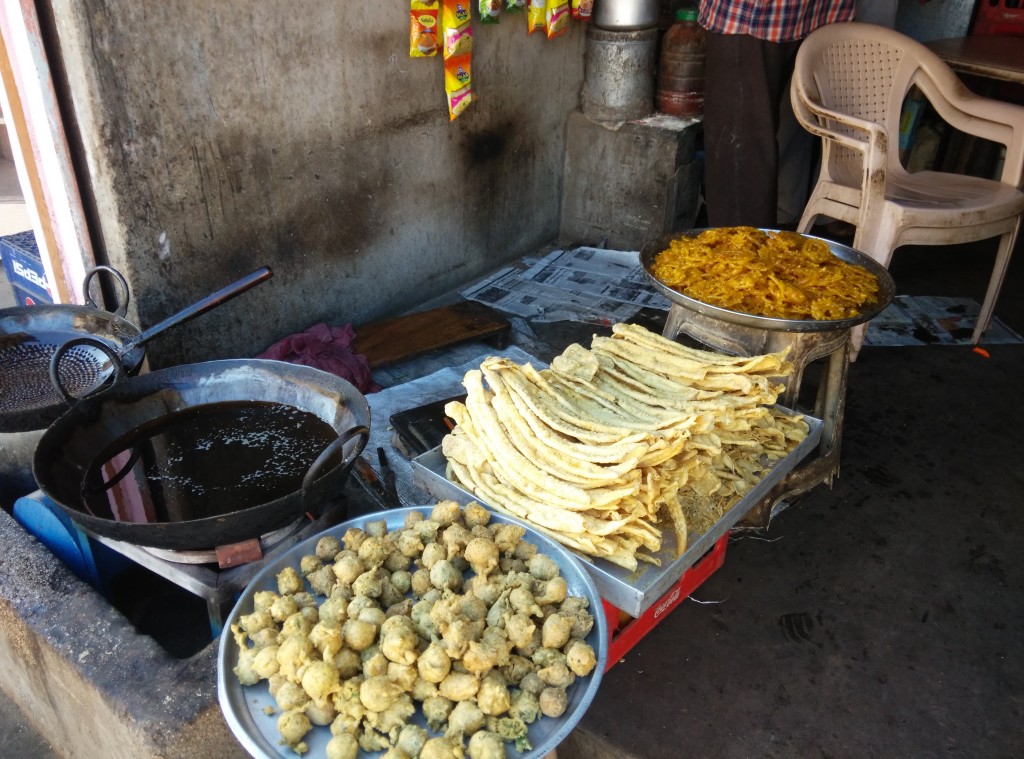
From Narayan Sarovar, we went to Lakhpat.
Lakhpat
{Lakhpat is a small town and sub-district in Kutch district, located at the mouth of Kori Creek. The town is enclosed by 7km long 18th-century fort walls. The literal meaning of Lakhpat is the city of millionaire as historically the town was bustling with port activities and had daily revenue of one lakh Kutch kori, the former currency.
Lakhpat has religious significance for three of India’s most populous religions: Guru Nanak, the founder of Sikhism, reportedly camped here on his journey to Mecca. The site later became a gurudwara, which holds some of Nanak’s possessions; Pir Ghaus Muhammed, a Sufi mystic who from the age of twelve devoted himself to spiritual practice and reportedly practiced half as a Hindu and half as a Muslim, is buried here in Lakhpat. His tomb is a stone construction with very complex carvings and a water tank that is said to have healing properties for skin problems; Sayyed Pir Shah’s nine-domed mausoleum has intricate carvings, doors, windows and jaalis}
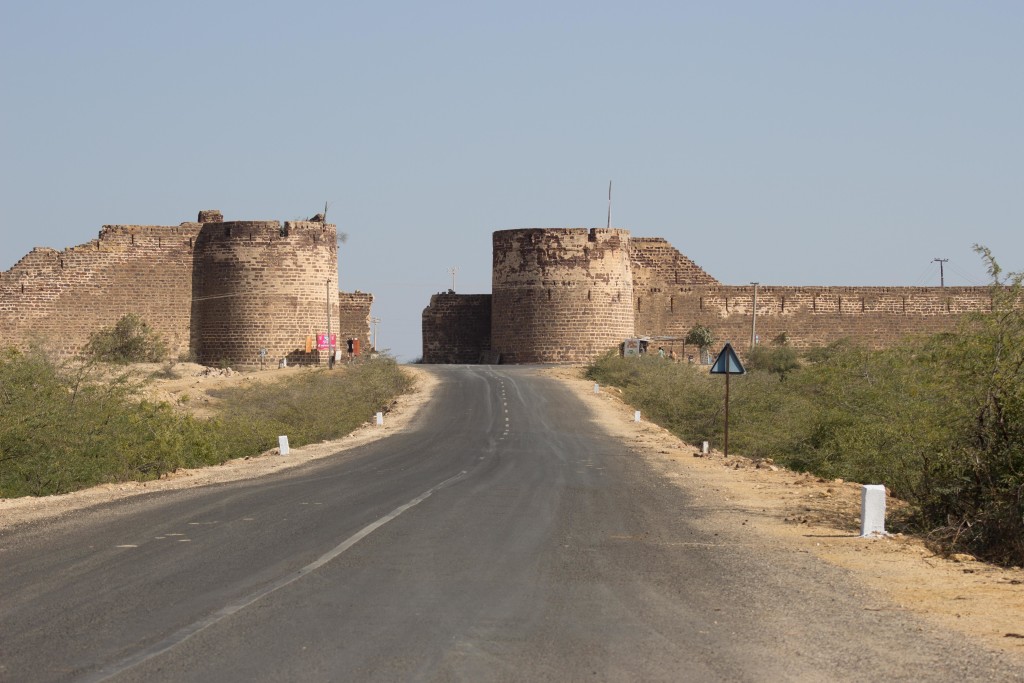

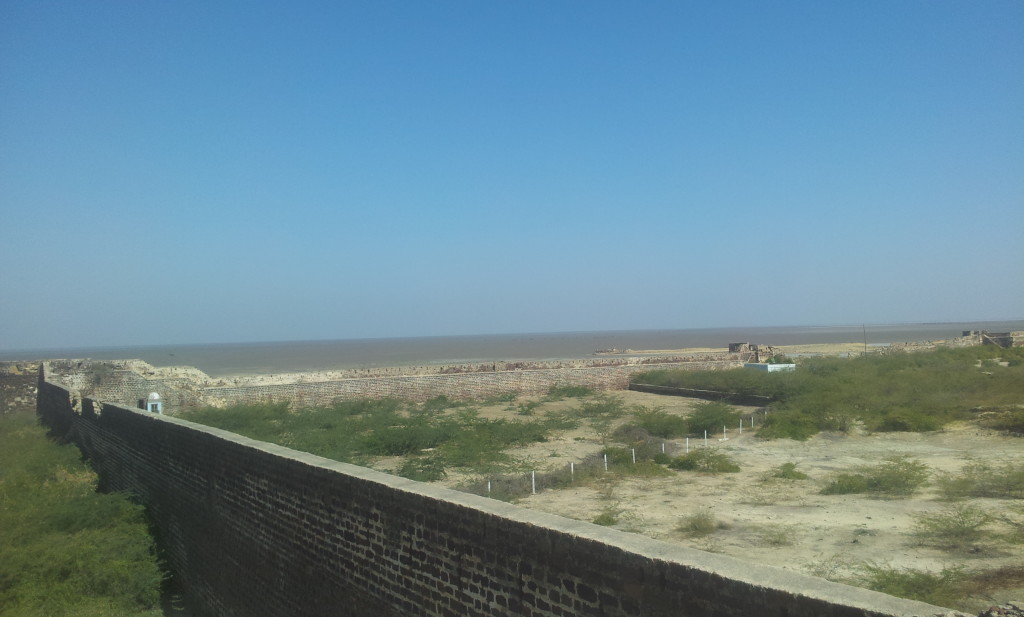
There is so much of news about Lakhpat in the net. But it is a ghost town now. There is hardly anybody in its small lanes. The first building we get to see is the Gurudwara. The whole complex is neat, clean, calm and cool. There are some belongings (footware etc) of Guru. We were offered lunch. Even though we had just finished our breakfast, the incharge of Gurudwara insisted that we must have our lunch here. What a great service! We finished our lunch.
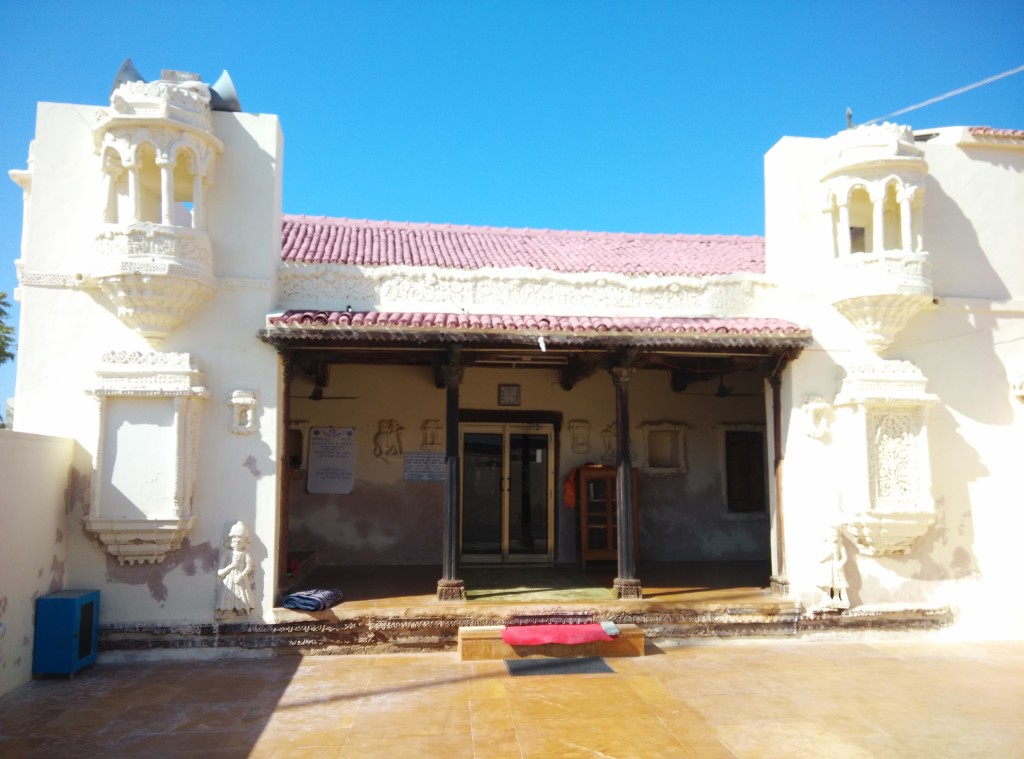
Then we saw the Pir Ghaus Muhammed Darga, and went till the end of the Fort. After spending few minutes there, we started our return journey to Bhuj in another route.
On our (return) journey, we came across the ‘Tropic of Cancer Line’. (We noticed this sign board in one more place in Gujarat, but we din’t stopped there to take the photos). We all have studied in our school that this line passes through India. In fact it passes in the states of Gujarat, Rajasthan, Madhaya Pradesh, Chattisgarh, Jharkhand, West Bengal, Tripura and Mizoram. When I searched the net, few states have put this ‘road sign boards’ of this line.
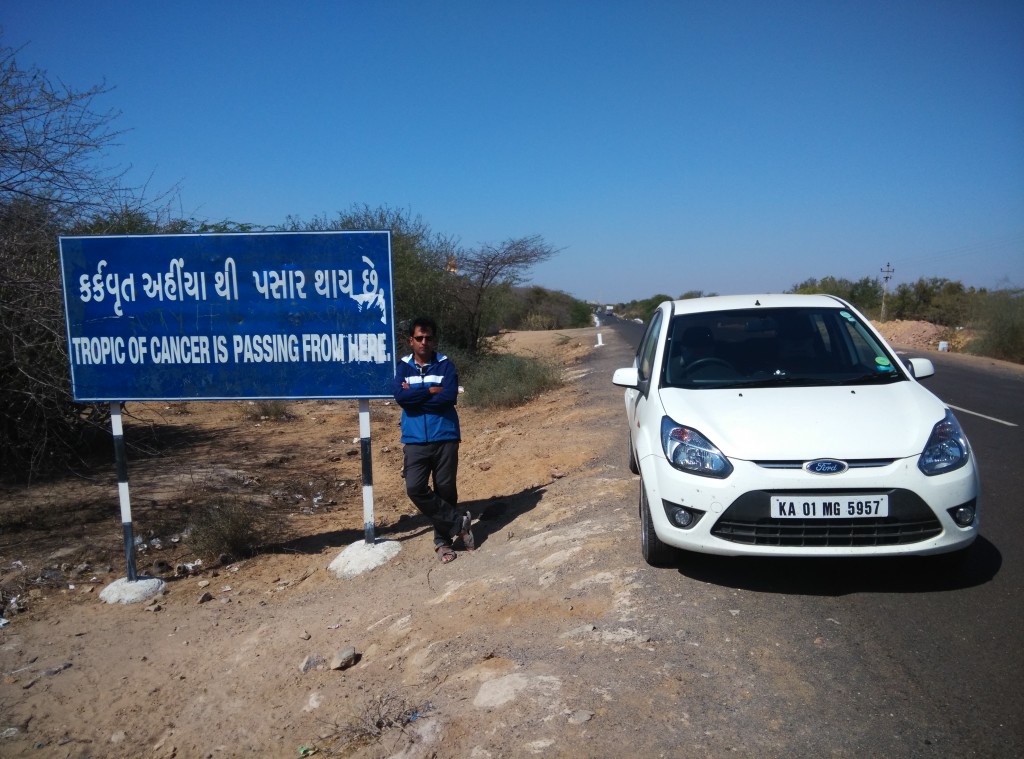

While I appreciate this, I thought more can be done here. The tourism dept. can make a small park/shelter kind of arrangement, where in people can stop their vehicles and take abundant photographs. The details of Tropic of Cancer, Capricorn, Equator etc can also be displayed here. And there can also be a refreshment stall, which will give job to some unemployed youths of the near by villages.
There after we reached Bhuj around 2.00 pm. This is our second tourist circuit of Kutch.
We straightaway went to BSF office in Bhuj. What, will we get the permits or not; was our million dollar question. The officer asked us to come back again around 5.30 pm.
Taking this as a blessing in disguise, we left for local Bhuj city sight seeing.
Bhuj
{Bhuj, a city and a municipality in Kuthc, is home to one of the first Swaminarayan Sampraday temples, built in 1822. The Kutch Utsav commencing on the last day of February is a window to this ancient land of heroism and romance. Places to visit are Kutch Museum, Darbargarh Palace, Kutch Desert Festival, Kutch Great Indian Bustard Sanctuary, Great Rann of Kutch, Kutch Desert Wildlife Sanctuary, Narayan Sarovar Wildlife Sanctuary etc}
The first place on our list was the Lake.
Hamirsar Lake
{This is an excellent place to cool off on a hot afternoon. Walking along the lake’s edge is a great way to get from one place to another, with the Aina Mahal and Prag Mahal, the Kutch Museum, the Ramkund Stepwell and Ram Dhun Temple, the Swaminarayan Temple, all located very close to the eastern side of the lake; a walk from the Aina Mahal to the Swaminarayan Temple (passing all the other sites mentioned) takes about half an hour. Further around the other side of the lake is the Sharad Baug palace, and the road to the royal chhatardis}
In fact we had seen this lake several times while criss crossing the city to BSF office, our room etc. Like Narayan Sarovar, this lake has also dried up substantially. There was very little water, making it a boring place to visit for us.
Then we went to the Ramkund step well.
Ramkund Step Well
{It is across from the Kutch Museum and behind the Ram Dhun Temple. Ramkund well is a square step well, 56’ on a side, with sculptures portraying characters from the Ramayana, as well as the ten incarnations of Lord Vishnu along the walls. On your walk down to the water you experience a sudden calm and coolness not to be found on the road above and in the quiet, you can pause for a while to reflect on your experiences. The Ram Dhun Temple, just in front of the well, is also worth a quick visit}
This is like the Brahm Kund of Shihor, but a small one. And there was water in the step well.

The museum was also close by. It opens at 3.00 pm.
Kutch Museum
{The Kutch Museum was originally known as the Fergusson Museum after its founder, Sir James Fergusson, a governor of Mumbai under the Raj. Built in 1877, it is the oldest museum in Gujarat and has an excellent collection. The well maintained exhibits include a picture gallery, an anthropological section, archaeological finds, textiles, weapons, musical instruments, a shipping section and, of course, stuffed beasts}
In general, I am not a great fan of any museum. Nevertheless we saw the museum and went to the Palace.
Prag Mahal
{Built in the 1860’s in a Venetian-Gothic style, Pragmalji’s Palace has pointed Gothic arches, classical colonnades and European truss timber roofs. The massive staircases and deep passages are floored with colorful Minton tiles and lined with handrails on classical balusters. The highlight is the Darbar Hall, which has Corinthian pillars, molded ceilings, huge Venetian chandeliers, Greco-Roman statutory, classical balustrade galleries and ceiling murals of Shakespearean characters. The furnishing is in the Victorian-Edwardian and art deco style.
Time: 9 am – 12 noon; 3 pm – 6 pm, Saturday closed}
This is a palace that we should not miss while in Bhuj. The 2001 earthquake has damaged the clock tower, but still we went to the top of the tower and had a panoramic view. As said, the Durbar hall is really beautiful.
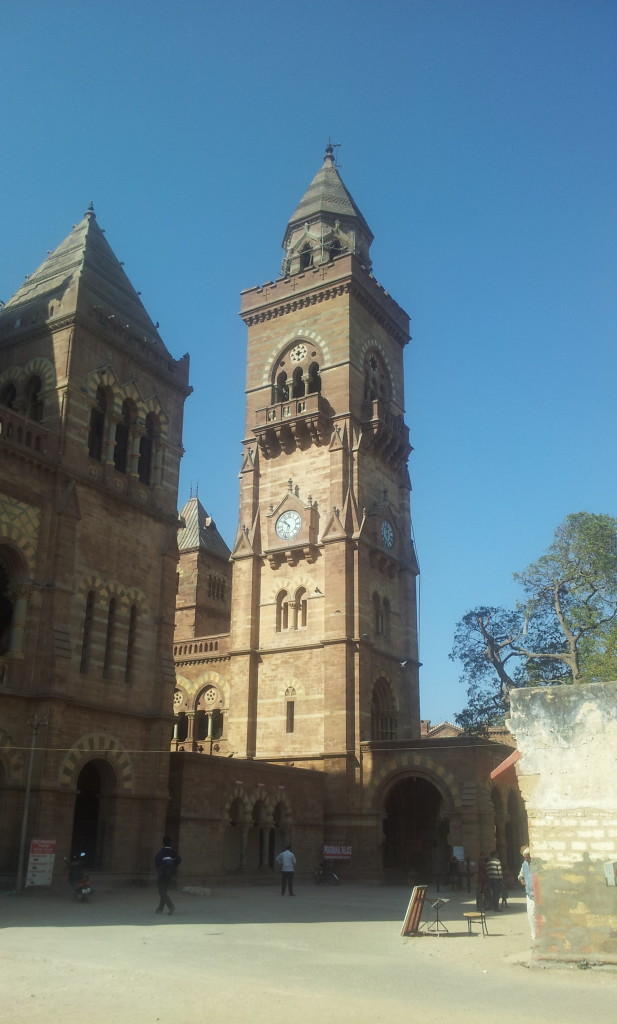
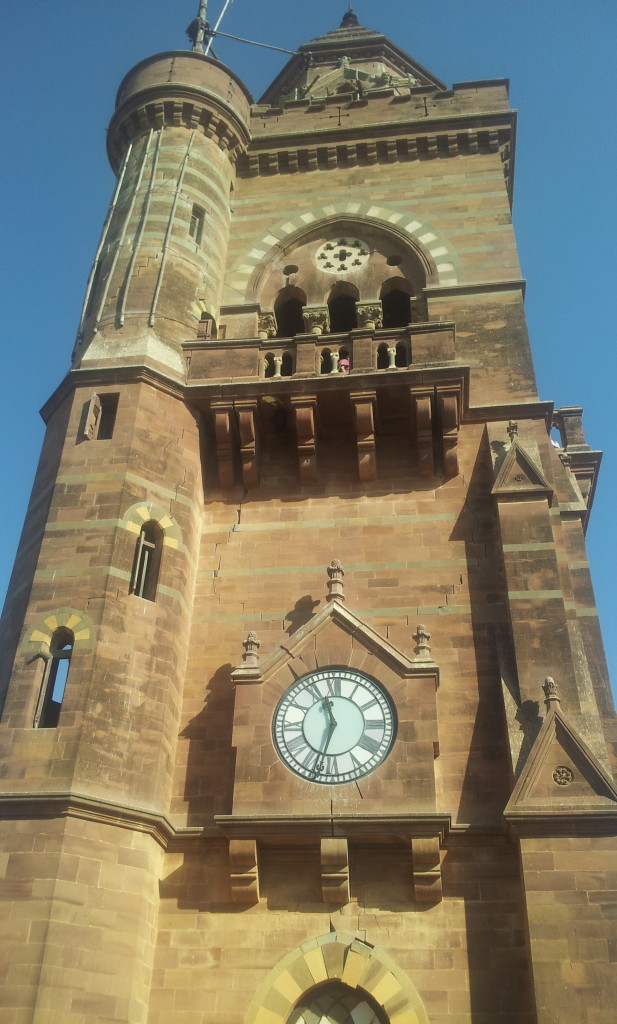
Aina Mahal
{Maharao Lakhpatji’s old palace, built in traditional Kutchi style, is in a small fortified courtyard in the old part of the city. It’s a beautifully presented museum and is one of the highlights of a visit to Bhuj. There’s a 15 mt long scroll depicting the Royal Procession of Maharao Shri Pragmalji Bahadur (1838-75). The real attraction is the Hall of Mirrors, created by the master artisan Ram Singh Malam. A blend of Indian and European artistry, the walls of the great hall are of white marble covered by mirrors. They are separated by gilded ornaments, lights provided by elaborate candelabra and shades of Venetian glass}
This is in the same compound of the Prag Mahal Palace. And is a worthy place to visit. Photography is costly, hence we avoided the same.
It was now around 4.45 pm. That means we finished our Bhuj city tour in around 2.25 hours. And the third tourist circuit was also over.
For the first time in our hectic tour so far, we were actually ‘free’ for some time. Or, that is what we thought. So went back to our room, took some rest, and went to BSF office again at 5.30 pm. This time, there were many people like us. On enquiry with them, we came to know that they are from different walks of life. There were few Swamis from BAPS SNM, and few were Tour Operators; all were waiting to collect the permits. They also told us that they had given the application around 2 weeks back and have come to collect it today. So we became tensed, because we had given the request only yesterday.
The officer gave the permits to each one of them, one by one, at regular intervals. But he asked us to wait. He gave the permits to everyone by around 6.30 pm, and only two of us were there waiting for our permits. We politely asked whether we can get permits or not, because we can’t spare another day to see the places beyond India Bridge. He said he is too busy, and asked us to wait. And finally at 8.30 pm, he issued the permits to us.
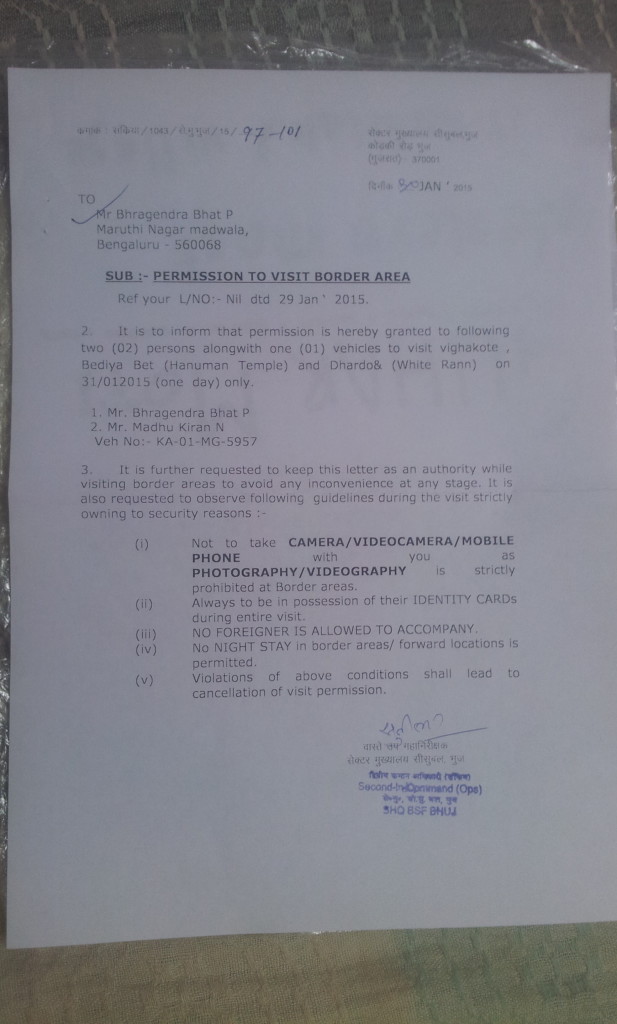
“Oh God, Thank you”, we said. At last we got it after waiting for a long time. (So we did not had any free time to roam around). We gave our profound thanks to the officer and left BSF.
After returning to Bengaluru, I enquired with some tour operators about this permit. They told me that it will take around 2 weeks and the fee charged for this is around 4 – 5,000/ INR. We were able to get it on the next day itself, that too without spending any amount.
There were two main reasons which helped us in getting this permit so quickly. The first one is that we have come all the way from Bengaluru in our own vehicle, and the second one was that we were continuously touring various parts of Gujarat. These two points worked in our favour.
We had dinner in the Mandir canteen, and settled in the room.
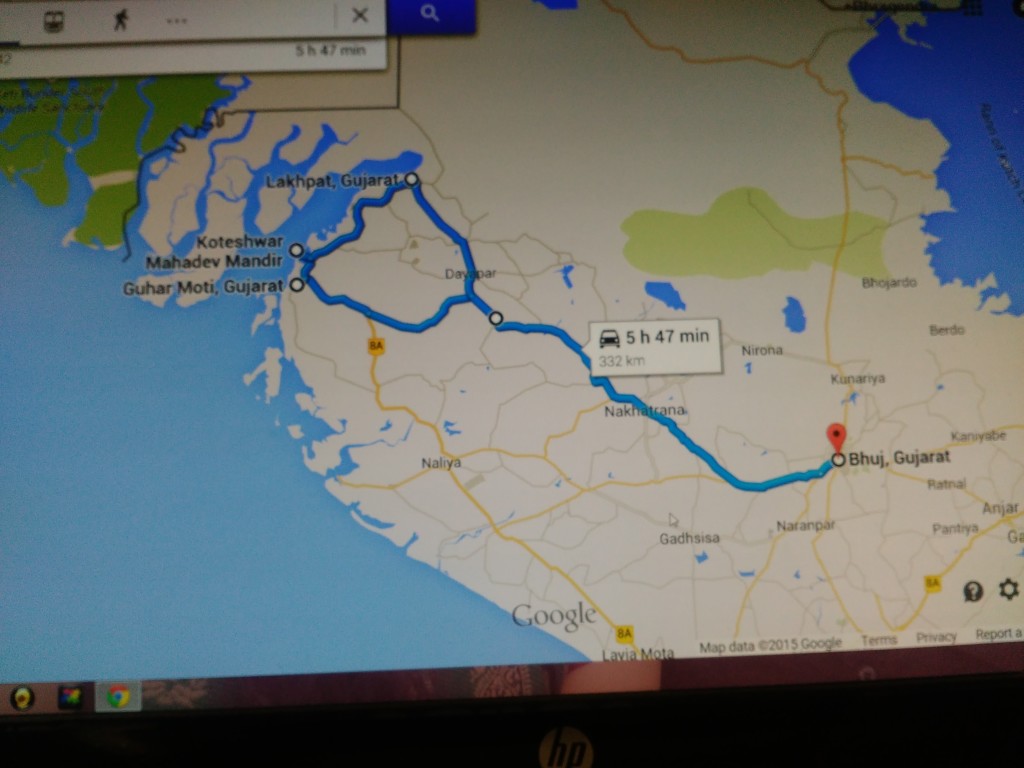
Total distance covered: 360 kms.
On Day 14 I explore more areas in the Great Rann of Kutch and then check out the Rann Utsav and Dholavira.
Read previous day’s account| Read next day’s account

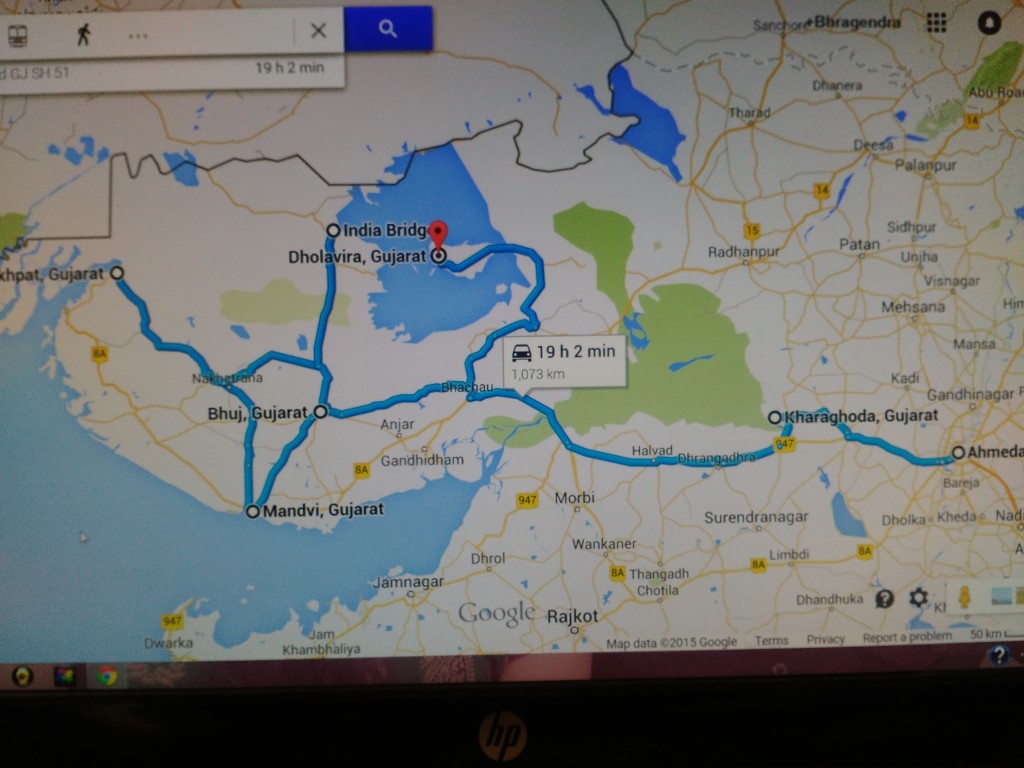





Dear Mr. Bhat,
Thank you very much for the informative blog. I believe this is the most effective and informative blog i have come across for Gujarat circuit.
Even though I am Gujarati and roaming a lot, I learnt many places from you.
Great Sir, Keep it up.
Thanks for sharing your journey detail and experience in detail.
i am sorry please tell me how to reach Guhar Moti from Mata No Madh…
A wonderful travelogue Mr. Bhat, thanks a lot for the wonderful account….i am planning to visit Kutch the coming winter, please tell me how to reach Guhar Moti from koteshwar